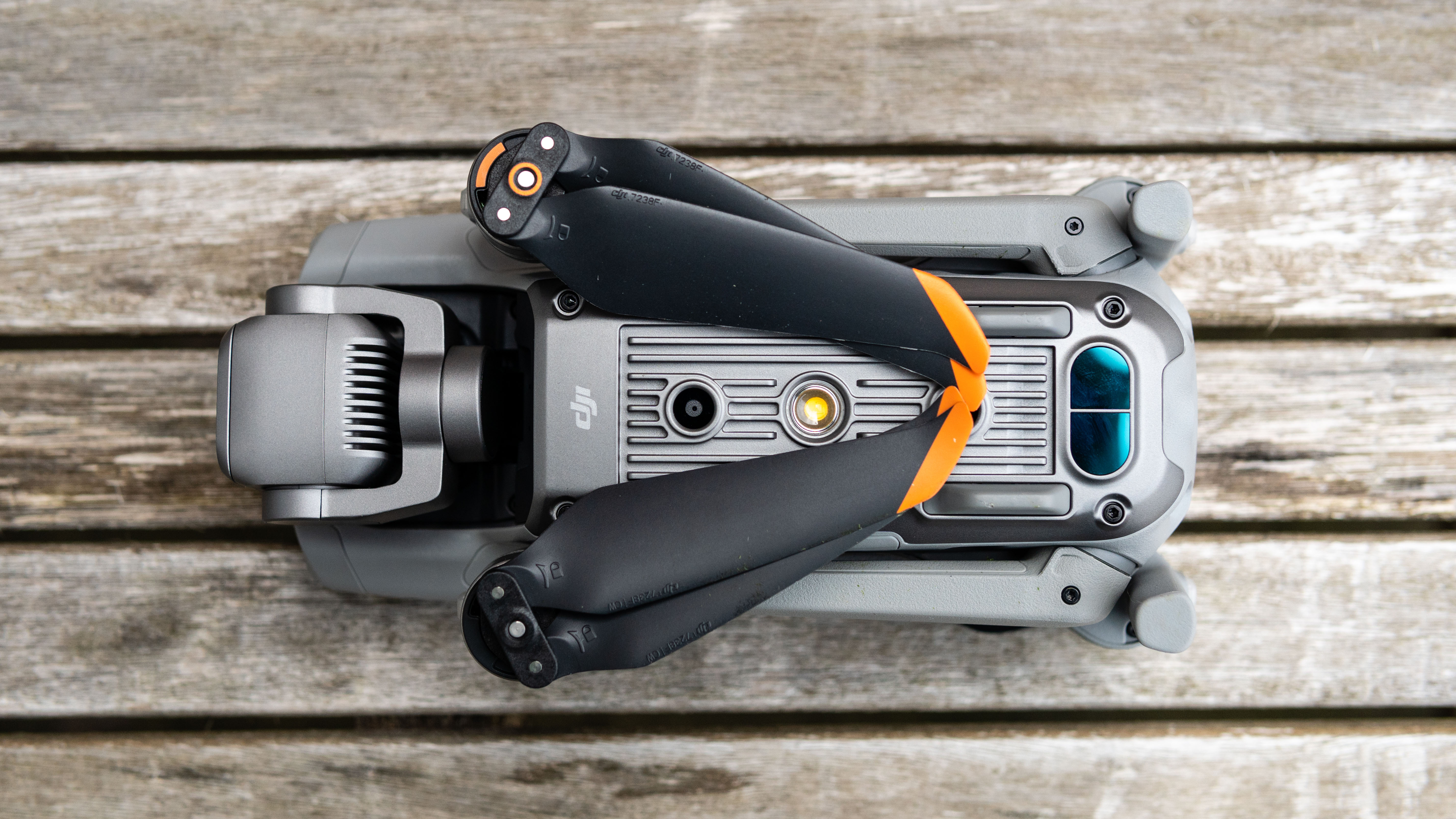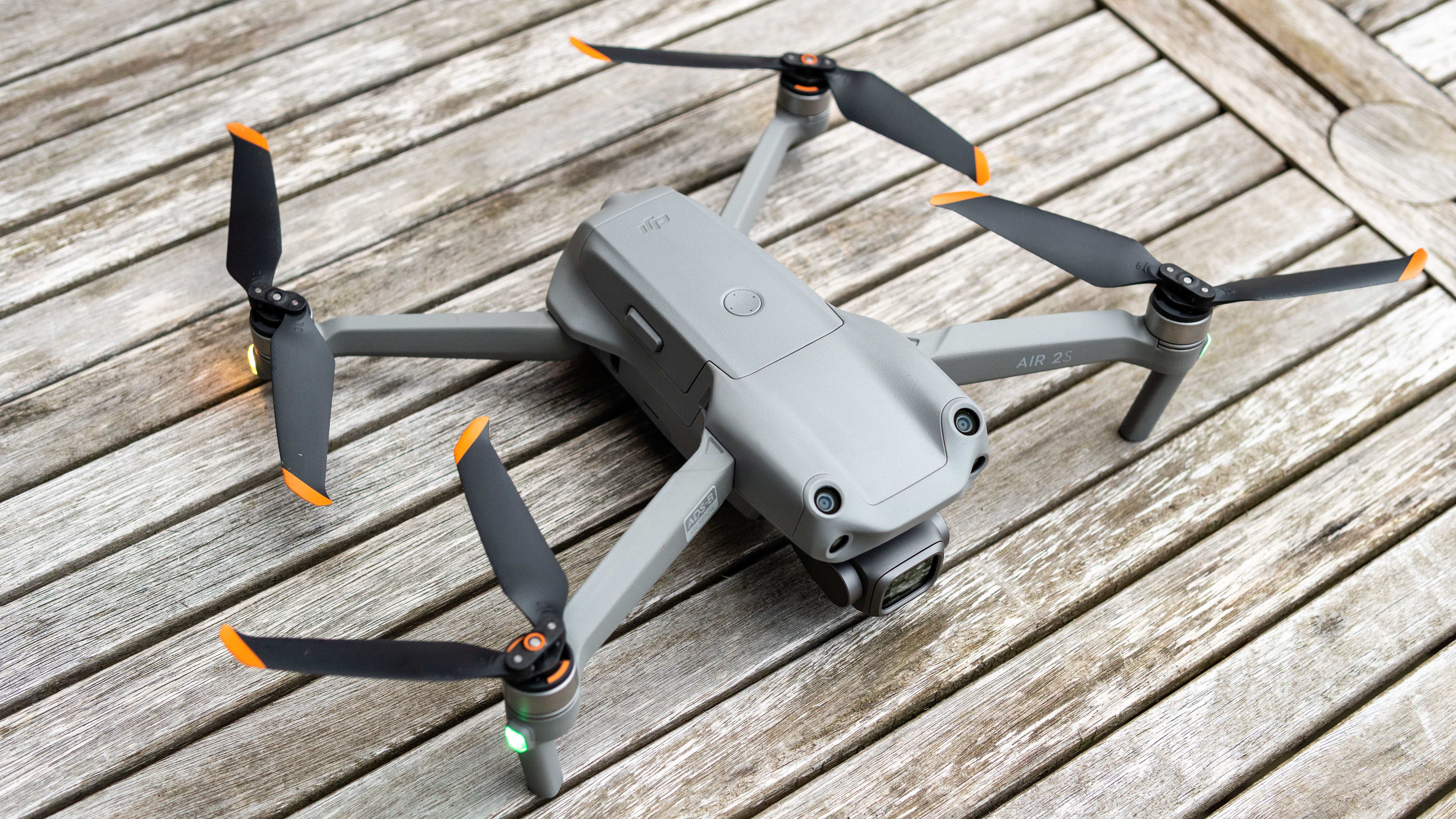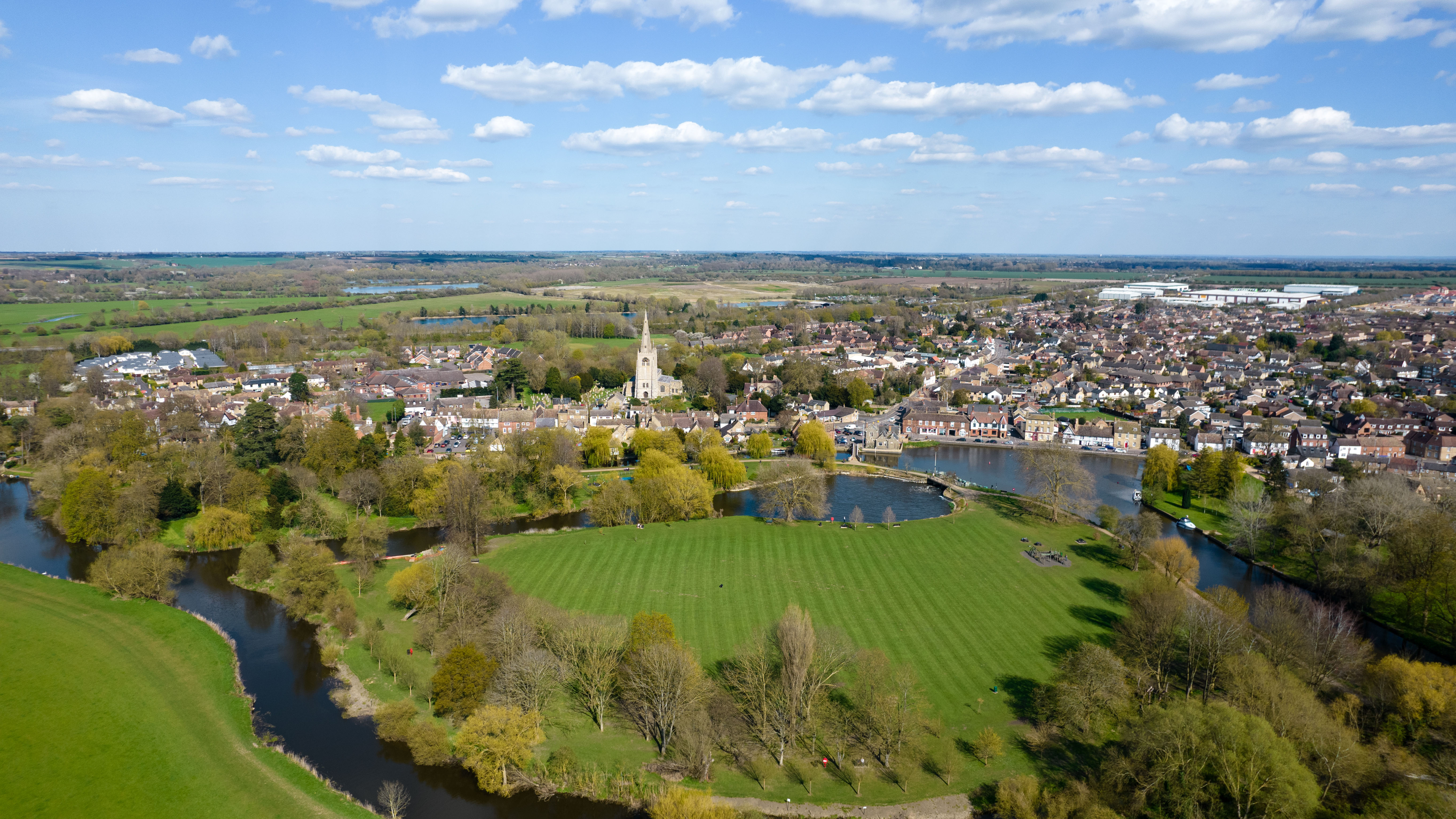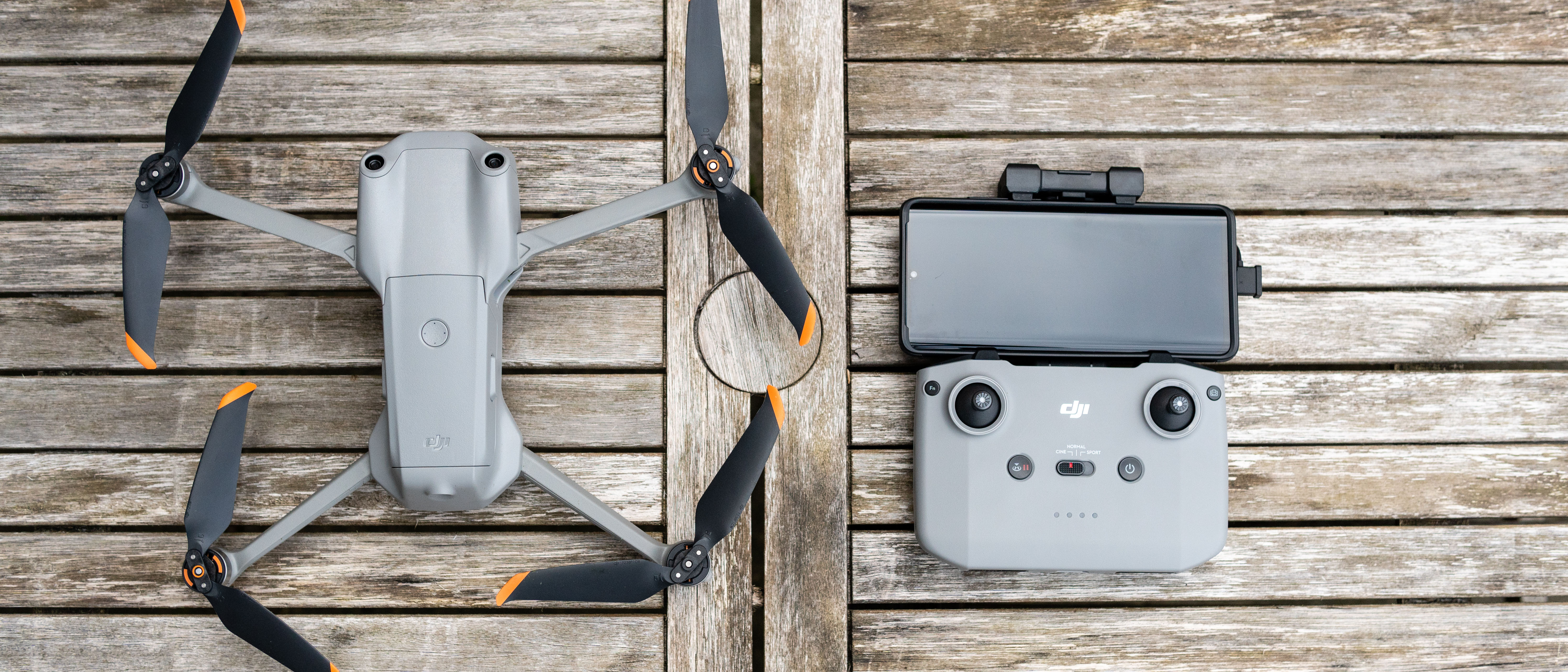Space Verdict
With a host of impressive features including a 20MP one-inch sensor in a drone weighing just 21oz, the Air 2S is an exciting option for photographers and videographers.
Pros
- +
20MP one-inch sensor
- +
Advanced safety features
- +
Small and lightweight
Cons
- -
Fixed f/2.8 rather than adjustable aperture
- -
Fixed-size controller
- -
Digital zoom use is limited
Why you can trust Space.com
Released in spring 2021, the DJI Air 2S is the most compact and lightweight drone available with a one-inch sensor, coming in at an astonishing 21oz / 595g. This is an exciting proposition in itself, but that’s not all. This drone is also capable of shooting video at up to 5.4K alongside 4K video up to 60fps, which pitches the Air 2S above and beyond the Mavic 2 Pro in terms of video.
Weight: 21oz / 595g
Folded dimensions: 7.1 x 3 x 3.8 inches
Unfolded dimensions: 7.2 x 3 x 10 inches
Battery: 3500 mAh LiPo 3S / up to 31 minutes
Charger type: AC Mains / 100-240V, 50/60 Hz, 1.3 A
Modes: Sport, Positioning, Cine
Camera sensor: 1-inch CMOS
Video transmission range: 12km
Video resolution: 5.4K, 4K, 2.7K, 1080p (FHD)
Frame rates: 5.4K up to 30 fps / 4K up to 60 fps / 2.7K up to 60 fps / FHD up to 120 fps
One area where the Air 2S is lacking, however, is that the camera features a fixed f/2.8 aperture so there’s no ability to control exposure while the drone is in the air beyond changing shutter speed and ISO, so a set of ND filters are essential for video shooters.
But in general the Air 2S model is an improvement over its predecessors, offering improved safety features, new camera functionality and a handful of new flight features, too. Image and video quality is excellent overall, providing everything drone pilots need whether complete beginners or full-time professionals. For that reason, we rank it as one of the best drones available on the market. If you do purchase one of these models, make sure you look through our drone photography tips to get the most out of it.
This definitely doesn't fall into the toy category, though, so you'll need to follow all the drone regulations that have been laid out by your local aviation authorities.
Design



- Compact, lightweight and portable
- Excellent build quality
- Fixed-size controller
In terms of the basic design, the Air 2S is extremely similar to the DJI Mavic 2 Pro although in a much smaller and lighter package. The propeller arms are folded in for transportation and folded out for flight, with the front arms swinging out while the rear arms rotate down and out. Build quality is excellent, and all moving parts feel robust and reliable.
The Air 2S boasts some impressive portability credentials, weighing in at just 21oz, with a folded size of 7.1 x 3 x 3.8in and an unfolded size of 7.2 x 3 x 10in. Of course, that extra unfolded size is just the extended propeller arms and the drone body remains the same, so it’s still extremely small in both configurations.
The controller moves away from the folding design of that used with the Mavic 2 Pro and is instead a fixed size with a larger battery, so battery life is generally better. But rather than attaching phones to arms at the bottom of the controller like the Pro, this controller uses a telescopic grip at the top to support phones. The control sticks unscrew for transportation and can be stowed away in the rubber sections at the bottom of the controller.
Breaking space news, the latest updates on rocket launches, skywatching events and more!
Functionality

- Advanced Pilot Assistance System
- ADS-B aviation technology
- Maximum speed of 42.5mph/68km/h
Flying the Mavic Air 2S is extremely easy and safe thanks to front, rear, bottom and top obstacle sensors; these use binocular zooming technology to recognize objects from further away to increase effectiveness. Then there’s the Advanced Pilot Assistance System (APAS) 4.0, which can be can set to stop the drone or to autonomously fly around, under or over obstacles when they’re detected to maintain smooth and continuous flight.
The Air 2S also features AirSense which uses ADS-B aviation technology to receive signals from nearby aeroplanes and helicopters and displays their locations on the on-screen map on the DJI Fly app. Plus there’s the GEO 2.0 geofencing system, which helps to keep the drone away from restricted airspace around locations such as airports.
These features come alongside GPS positioning to hold the drone in place when hovering so it doesn’t get blown away by the wind. And there are multiple automated flight patterns and subject following modes to make complex videos achievable by anyone, and these can be found within the Quickshots section of the app.
The maximum flight time of the Air 2S is 31 minutes, which is impressive considering the small batteries, although in real-world flying a more realistic expectation is for flight times to last around 20 minutes. The most power is used when flying in Sport Mode, where the drone can reach speeds of up to 42.5mph/68kmh, which is only marginally slower than the larger and more powerful Mavic 2 Pro. Other flight modes include Positioning Mode (P) where all sensors are active and Cine (C) where speed is restricted and controls are less sensitive for shooting cinematic-looking video footage.
Performance




- 20MP 1-inch sensor
- Up to 5.4 K video
- 8x digital zoom
The Air 2S camera features a 20MP one-inch sensor and a full-frame equivalent focal length of 22mm with a fixed aperture at f/2.8 and a focus range of 60cm to infinity. ISO control of 100-12,800 is available for stills, while 100-1600 is available for video. And in terms of noise handling, the Air 2S provides in-camera processing that’s applied even to Raw files but does produce great results where noise only becomes noticeable at ISO 6400.
In terms of image quality from the fixed 22mm equivalent lens, images produced are sharper in the centre with a fall-off in sharpness towards the edges, although this is common with most consumer drones so it isn’t a major issue overall. And despite the fixed lens, the Air 2S features a digital zoom that allows you to get closer to the action without the drone being physically closer, which is incredibly useful. However, the maximum setting you’d want to use is 2x because image quality naturally reduces the more it’s applied – up to 4x in 4K and 8x in FHD.
For stills photography, you can shoot in Raw, JPEG or both, and for video you can shoot in standard colour profiles for straight out of camera footage, D-Log (10 bit) for professional quality Raw footage or HDR in HLG (10 bit). In terms of video frame rates, it’s possible to shoot 5.4K at 24/25/30 fps, 4K at 24/25/30/48/50/60 fps, 2.7K at 24/25/30/48/50/60 fps and FHD at 24/25/30/48/50/60/120 fps.
Cost
The Mavic Air 2S is available in a standard kit or Fly More Bundle. The standard kit consists of the drone, controller, one battery, propellers, a spare pair of propellers, a charger and all cables costing £899 / US $999. The Fly More Bundle is great value at £1169 / US $1299 because as well as including everything in the standard kit, you also get two additional batteries, additional spare propellers, a three battery charging hub, a shoulder bag and a set of four ND filters.
Should you buy the DJI Mavic Air 2S?
The Air 2S is the perfect combination of size, weight and features, making it ideal for people who like to take a drone with them on days out. The safety features make it an incredibly safe and intuitive drone to fly, but don’t forget that the weight of the drone means that you’ll need to register with the CAA (UK) or FAA (US) before you can fly it. This is a simple and inexpensive process so don’t be put off, although it’s always something to bear in mind.
So, whether you’re an absolute drone beginner or a professional photographer or videographer looking for a highly portable drone to compliment your existing kit, the Air 2S is a fantastic option that will undoubtedly work for you.
However, there are rumours that DJI is shortly going to announce a new drone: the DJI Mavic 3 Pro. This could boast a plethora of new features, including (if the rumours are true) a duo camera set-up, with one of them featuring a telephoto lens and the other offering a 20MP Four Thirds sensor.
If you're desperate to have the latest and most impressive prosumer model, then it might be worth waiting for this. There's a chance that the price of the Air 2S model will drop after the announcement, too, but that's not a guarantee. In fact, given the ongoing supply chain issues within the industry, it might be worth moving quickly if you do see a decent price on an available drone.
If this product isn't for you
For an exhilarating experience and video providing an immersive first-person point of view, the DJI FPV combo including the drone, controller and DJI Goggles is a great option. It’s not great for stills though, so only consider this if you’re looking to have some fun and get some FPV video footage.
If budget is an issue, consider the Mavic Air 2 which features a smaller camera and sensor than the Air 2S but is still packed with great features. This drone is also available in both a standard kit and a Fly More Bundle with additional useful accessories.
If you’re looking for an even smaller and more portable drone, the DJI Mini 2 is a tiny drone that weighs just 0.55lbs / 249g. This tiny drone can shoot Raw stills and up to 4K video in standard colour profiles but not Raw.
James is an award-winning freelance landscape and portrait photographer, as well as a highly experienced photography journalist working with some of the best photography magazines and websites with a worldwide audience. He’s also the author of The Digital Darkroom: The Definitive Guide to Photo Editing. www.jamesaphoto.co.uk


